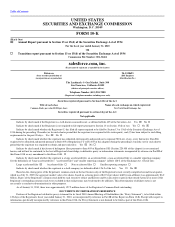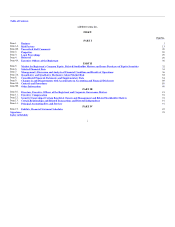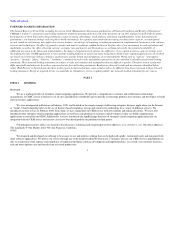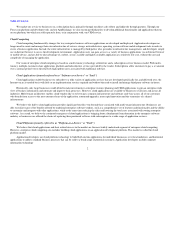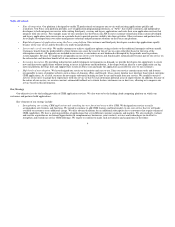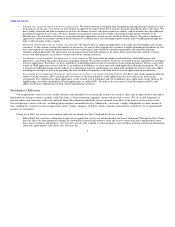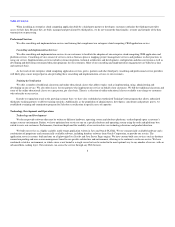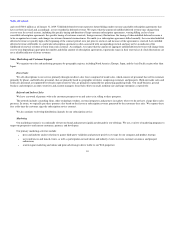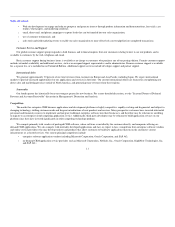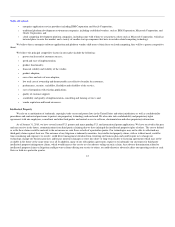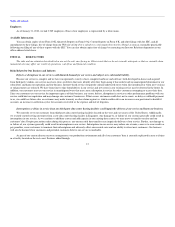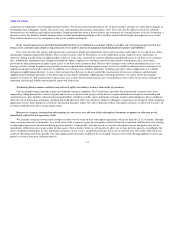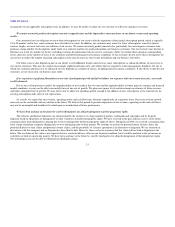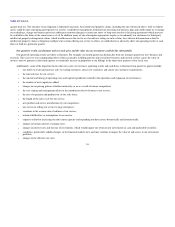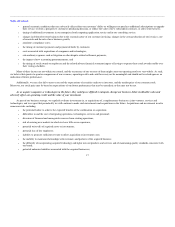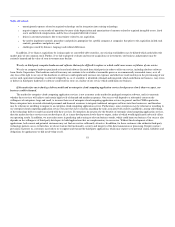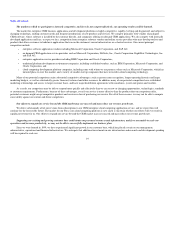Salesforce.com 2009 Annual Report Download - page 12
Download and view the complete annual report
Please find page 12 of the 2009 Salesforce.com annual report below. You can navigate through the pages in the report by either clicking on the pages listed below, or by using the keyword search tool below to find specific information within the annual report.
Table of Contents
Our service treats all customers as logically separate tenants in central applications and databases. As a result, we are able to spread the cost of
delivering our service across our user base. In addition, because we do not have to manage thousands of distinct applications with their own business logic and
database schemas, we believe that we can scale our business faster than traditional software vendors. Moreover, we can focus our resources on building new
functionality to deliver to our customer base as a whole rather than on maintaining an infrastructure to support each of their distinct applications.
Our research and development efforts are focused on improving and enhancing the features, functionality and security of our existing service offerings
as well as developing new proprietary services such as Force.com. In addition, from time to time we supplement our internal research and development
activities with outside development resources and acquired technology. Because of our common, multi-tenant application architecture, we are able to provide
all of our customers with a service based on a single version of our application. We are able to upgrade all of our customers at the same time with each
release. As a result, we do not have to maintain multiple versions of our application.
Operations
We currently serve our customers from third-party data center hosting facilities located on the west and east coasts of the United States. Additionally,
we recently started serving customers from a new data center hosting facility in Singapore. All of our hosting facilities are currently leased from Equinix, Inc.,
except for features added through acquisition which are temporarily served through alternate facilities.
The Equinix facilities are built to the same critical systems building codes as hospitals and other vital infrastructure. The facilities are secured by
around-the-clock guards, biometric access screening and escort-controlled access, and are supported by on-site backup generators in the event of a power
failure. As part of our current disaster recovery arrangements, all of our customers' data is currently replicated in near real-time. This strategy is designed to
both protect our customers' data and ensure service continuity in the event of a major disaster. Even with the disaster recovery arrangements, our service could
be interrupted.
Our agreement with Equinix provides for Equinix to supply space in its secure facilities as well as power. Bandwidth to the Internet is provided by
multiple independent companies. We continuously monitor the performance of our service. The monitoring features we have built or licensed include
centralized performance consoles, automated load distribution tools and various self-diagnostic tools and programs.
In addition we have a data center in San Francisco, which is primarily for internal information technology, development and quality assurance
infrastructure.
Customers
Our revenues are divided among small businesses (companies with fewer than 200 employees), medium-size businesses (200 or more employees and
up to $1 billion in annual revenues), and large businesses (over $1 billion in annual revenues). The number of paying subscriptions at each of our customers
ranges from one to tens of thousands. None of our customers accounted for more than 5 percent of our revenues in fiscal 2010, 2009, or 2008.
Sources of Revenue
We generally recognize revenue ratably over the contract terms beginning on the commencement date of each contract. Amounts that have been
invoiced are recorded in accounts receivable and in deferred revenue or revenue, depending on whether the revenue recognition criteria have been met. The
deferred revenue balance on our Consolidated Balance Sheet does not represent the total contract value of an annual or multi-year, non-cancelable
subscription agreements. Unbilled deferred revenue was over $1.0 billion as of January 31, 2010
9


